| 15 BC - AD 445 |
The region is part of the Roman empire. |
|
| c.445 - 451 |
The Hunnic empire controls the area. |
|
| c.451 - 488 |
The Ostrogoths' territory now encompasses the area. |
|
| 488 - 568 |
The region falls under the control of the Langobards until they move into northern Italy. |
|
| 568 - 788 |
The area is occupied by the Bavarii as they migrate into what becomes their traditional territory. |
|
| 788 - 843 |
The region is conquered and controlled as part of the Carolingian empire of the [Western Franks](FranceFranks.htm#Western Franks). |
|
| 843 - 907 |
The Treaty of Verdun. The [Western Franks](FranceFranks.htm#Western Franks) secede from the Germanic empire, and Austria is controlled by theEast Frankish rulers of the fledgling Holy Roman empire. |
|
| 880 - 907 |
Aribo |
Governed the East Mark (Ostmark). Also ruled Styria. |
| 907 - 955 |
Former Bavarian Austria passes to the Magyars, until the latter are defeated by Saxon emperor Otto I. |
|
|
|
|
| Margraves of Austria (Regensburg) c.AD 960 - 975 Now that the German Holy Roman empire had full control of Austria, the title of margrave was granted to its ruler. The march of Austria, created from former [Bavarian](GermanyBavarians.htm#Duchy of Bavaria %28Welfs%29) territory that had been captured from the Magyars in 955, was duly recognised around this date as a margraviate. It sat on Bavaria's north-eastern border, immediately above another Bavarian possession,[Carinthia](EasternCarinthia.htm#Duchy of Carinthia). In part its predecessor was the march of Pannonia, an Eastern Frankish possession in former Avar lands. The German word 'march' or 'mark' was also rendered in Old English as 'mierce', meaning 'boundary, borderland'. The English kingdom ofMercia bore this name for much of its existence. Germanic or Scandinavian states or regions such as the North March, Denmark, Finnmark, Hedmark, Ostmark, andVingulmark were named for the same reason. (Additional information by Edward Dawson.) |
|
|
| c.960 - 975 |
Burchard |
|
| 962 |
With the accession of the Saxon king, Otto I, the power of the Germanic Roman empire is confirmed. Otto is quite vigorous in establishing new counties and border areas within and without the empire's borders. The county of Ardennes under Sigfried gains the stronghold of Lucilinburhuc (the later Luxemburg), Arnulf I the Elder is restored in Flanders, and the 'March of Austria' is formed (or confirmed) from territory which had already been captured from the early Hungary (possibly by 960). 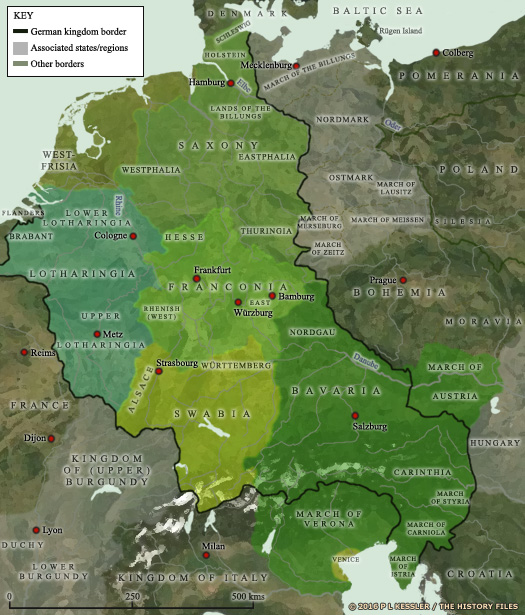 Germany in AD 962 may have had its new emperor to govern those territories which are shown within the dark black line, but it was still a patchwork of competing interests and power bases (click or tap on map to view full sized) Germany in AD 962 may have had its new emperor to govern those territories which are shown within the dark black line, but it was still a patchwork of competing interests and power bases (click or tap on map to view full sized) |
|
| At the same time,Saxony gains Hermann Billung as its duke, charged with maintaining the duchy's eastern borders and expanding them further to the east, alongside the recently-created North March. Perhaps as a reaction to this or as the culmination of a process that is already heading that way, the duchy of Poland is formed around the same time. |
|
|
|
|
|
| Margraves of Austria (Babenberg) AD 976 - 1248 It was probably Charles 'the Fat', titular head of the Frankish empire with the title of Emperor Charles III, who appointed Henry of Babenberg, his right-hand man, as the acting count of Franconia in AD 882. Henry may have been the son or grandson of Poppo I, count in the Grapfeld in early north-eastern Franconia before the region had coalesced into a single county in its own right. Poppo himself was a grandson of Heimrich, count in the Upper Reingau in the late eighth century (a gau being an official term for the various districts within Frankish Germany at this time), a territory that later formed part of Hesse. However, the Austrian Babenburgs cannot definitively be linked to the Franconian Babenburgs. Austrian historians usually point to the name Leopold which, in its original form should be shown as Luitpold, and insist on him being a collateral line of the Luitpoldings of [Bavaria](GermanyBavarians.htm#Duchy of Bavaria %28Welfs%29) and [Carinthia](EasternCarinthia.htm#Duchy of Carinthia). Between Leopold von Babenberg becoming margrave of the Ostmark, and 1246, the duchy of Austria was only part of the extensive feudal possessions of the Babenberg family. The dynasty established their first residence in Pöchlarn before moving it to Melk in the scenic Wachau region. (Additional information from The New Cambridge Medieval History: Volume 3, c.900-c.1024, Timothy Reuter & Rosamond McKitterick (Eds), and from External Links: History Extra, and Austria, the Official Travel Guide.) |
|
|
| 976 - 994 |
Leopold I / Luitpold |
Family disputed. |
| 994 - 1018 |
Henry I |
|
| 1012 |
The young Herman III of[Swabia](GermanySwabia.htm#Dukes of Swabia) dies childless, ending the Conradine succession to the duchy. Through his marriage to Gisela, heiress of Swabia (and Herman's sister), Ernest I of Babenburg, son of Margrave Leopold I, becomes duke of Swabia. |
|
| 1015 |
Following the untimely death of Duke Ernest I of[Swabia](GermanySwabia.htm#Dukes of Swabia), his son succeeds him as a minor. At first, the boy's mother is regent, but she is eventually replaced by Poppo, archbishop of Trier and another son of Leopold I of Austria. |
|
| 1018 - 1055 |
Adalbert |
|
| 1055 - 1075 |
Ernest |
|
| 1075 - 1102 |
Leopold II |
|
| 1102 - 1136 |
Leopold III the Saint |
|
| 1136 - 1141 |
Leopold IV |
|
| 1137 |
The town of Vienna is first referred to as a city. In the same year the foundations are laid for a church that will one day evolve into St Stephen's Cathedral. |
|
| 1141 - 1177 |
Henry II Jasomirgott |
Title elevated to duke of Austria (1156). |
| 1146 |
Boris Kalamanos is a pretender to theHungarian throne. He has already attempted to lay claim to that throne during the reign of Bela 'the Blind'. Now he temporarily holds Pressburg (today's Bratislava in Slovakia) with the assistance of German mercenaries. King Geza comes of age in the same year, and it is he who clears up the situation by invading Austria to rout Henry Jasomirgott, margrave of Austria, at the Battle of the Fischa. |
|
| 1177 - 1194 |
Leopold V |
|
| 1189 - 1192 |
Leopold leads the small German contingent during the Third Crusade. Eager to establish his authority, he is easily pushed aside by Richard of England. Whilst there, the choice of Conrad de Montferrat as king of Jerusalem at Acre is a contentious one. Despite being a major player in the crusade and being the rightful successor to the throne through his marriage to Isabella, younger sister of Queen Sibylla, Conrad is opposed by Richard. However, all the barons support Conrad, as do his cousins, Leopold himself and Philip II of France. Satisfied, Philip returns home, as does Leopold, meaning that Richard is now the undisputed leader of the Third Crusade. Manoeuvring politically against Richard for supremacy, Conrad is attacked in the street by assassins and dies of his wounds. Richard himself leaves the Holy Land, to be captured and imprisoned by Leopold. The pregnant Isabella, now heir to the throne of Jerusalem by near-universal agreement, is quickly married off to Henry de Champagne. |
|
| 1192 |
The margraviate of Styria passes to Babenburg-controlled Austria and remains a permanent possession. The duchy of Austria, however, is prone to change hands in the next century - from the Babenburgs to the Zahringens to the Przemyslid, and finally to the Habsburgs, who use it as a title for junior members of the dynasty. |
|
| 1194 - 1199 |
Frederick I |
|
| 1199 - 1230 |
Leopold VI the Glorious |
|
| 1230 - 1246 |
Frederick II the Warlike |
|
| 1241 - 1242 |
Mongol leaders Batu Khan and Subedei turn their attention farther into Europe. They enter Galicia, capturing the capital and destroying the cathedral there and ending any hopes that the Galicians might have had of holding onto Kyiv. Both Poland and Hungary are also conquered, with European defeats at Liegnitz and the River Sajo (the Battle of Mohi). Austria, Dalmatia, and Moravia also fall under Mongol domination, and the tide seems unstoppable. However, the death of Ogedei Khan causes the Mongols to withdraw, with Batu Khan intent on securing his conquests in the lands of the Rus thanks to the possibility that his rival, Guyuk Khan, could be elected great khan. |
|
| 1246 - 1248 |
Frederick III |
|
|
|
|
| Dukes of Austria (Zahringen) AD 1248 - 1250 |
|
|
| 1248 - 1250 |
Herman |
Herman VI ofBaden. |
|
|
|
| Dukes of Austria (Przemyslid) AD 1250 - 1278 Ottokar II the Great was also known as 'the Golden' and 'the Iron', as he greatly enriched and strengthened his [Bohemian](EasternBohemia.htm#Ottokar II) lands and his people, the Czechs. Unfortunately they destroyed the gold market in Europe by oversupplying it with their own intensive mining. They also supplied the silver coins which they called Tolar (from which the modern word 'dollar' originates). |
|
|
| 1250 - 1278 |
Ottokar II the Great |
King of [Bohemia](EasternBohemia.htm#Ottokar II). Also held [Carinthia](EasternCarinthia.htm#Duchy Premyslids),Slovenia, & [Styria](EasternStyria.htm#Slav Kingdom in Carinthia). |
| 1256 |
The previous duke of[Carinthia](EasternCarinthia.htm#Duchy Spontheims), Ulrich III, had secretly agreed in 1268 to be succeeded by Ottokar, his [Bohemian](EasternBohemia.htm#Ottokar II) wife's nephew. This is despite also having formally recognised his own brother as his successor, Philip, archbishop of Salzburg. Ottokar makes good on his agreement upon Ulrich's death in 1269, with the old duke having outlived his own children. The duchy of[Carinthia](EasternCarinthia.htm#Duchy Premyslids) is appended to Ottokar's own powerful Bohemian kingdom. As he already holds Austria, this gives him a continuous corridor of territory down into neighbouring[Styria](EasternStyria.htm#Slav Kingdom in Carinthia). 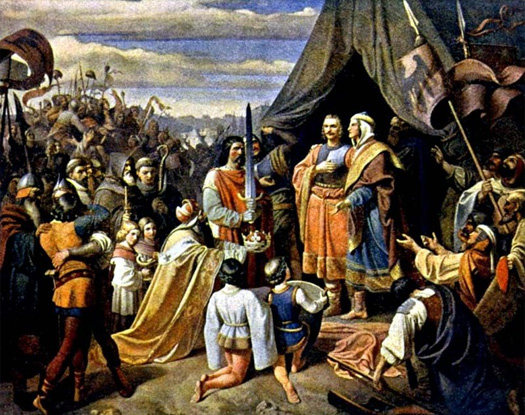 King Przemysl II Ottokar the Great, the 'Golden and Iron', was an inspirational empire-builder for his Czech kingdom of Bohemia-Moravia - he was also a capable politician, who managed to bring the state out of crisis and greatly strengthen it King Przemysl II Ottokar the Great, the 'Golden and Iron', was an inspirational empire-builder for his Czech kingdom of Bohemia-Moravia - he was also a capable politician, who managed to bring the state out of crisis and greatly strengthen it |
|
| 1271 |
Ottokar of [Bohemian](EasternBohemia.htm#Ottokar II) and Stephen of Hungary sign the First Peace of Pressburg (Pozny to the Hungarians, modern Bratislava in Slovakia). This follows another battle between the two over Hungarian claims to areas of Austria and Slovakia (to the east of Moravia, sandwiched between that and Hungary), and Bohemian-captured territory in Hungary itself. Each claim is dropped so that Bohemia unquestionably rules Austria and Slovakia, and Hungary is fully restored to its rulers. |
|
| 1276 - 1278 |
Rudolph of Habsburg wrests the duchy[ Austria](#Habsburg Margraves) from Ottokar in 1276, and kills the Przemysl king in battle on the Moravia Field, on the right bank of the River Morava in Austria, two years later. |
|
|
|
|
| Dukes of Austria (Habsburg) AD 1278 - 1358 Rudolph of Habsburg had already been involved in European politics before gaining the duchy of Austria. In 1266 he had invaded the Savoyard canton of Vaud, briefly capturing the chateau there before being expelled by the troops of Count Peter II. From this point forwards, the new Habsburg rulers of Austria became heavily involved in the title of Holy Roman emperor. After several non-dynastic periods of rule, from 1438 onwards the two titles became virtually indistinguishable. Following German custom, there were some subdivisions created within Habsburg-controlled territory, but no real power was handed out until 1379-1457, when the descendants of Albert III and Leopold III ruled the duchy and the Tyrol separately. The eastern rump of Franconia, now little more than a district in central Germany since its disintegration at the end of the twelfth century, is a favoured territory for the early dukes of Austria. (Additional information from External Link: House of Habsburg (dead link).) |
|
|
| 1278 - 1282 |
Rudolph I of Habsburg |
HRE (1273-91). Duke of [Austria](GermanyAustria.htm#Habsburg Margraves), [Carinthia](EasternCarinthia.htm#Duchy Habsburgs I), & [Swabia](GermanySwabia.htm#Dukes of Swabia). In Bohemia. |
| 1282 - 1283 |
In December 1282, as Holy Roman emperor, Rudolph gives the duchies of Austria and [Styria](EasternStyria.htm#Slav Kingdom in Carinthia) to his sons, Albert and Rudolf II respectively. [Carinthia](EasternCarinthia.htm#Duchy Habsburgs I) and Carniola are passed to Meinhard of Gorizia-Tyrol. On 1 June 1283, the Treaty of Rheinfelden stipulates that Rudolph II has to relinquish his title in favour of Albert. In compensation he is appointed duke of [Swabia](GermanySwabia.htm#Dukes of Swabia), little more than an honorific title as the duchy no longer exists as a coherent entity. Various minor territories previously held by the counts of Habsburg are later classed as Further Austria, but these are never possessed by Rudolph. 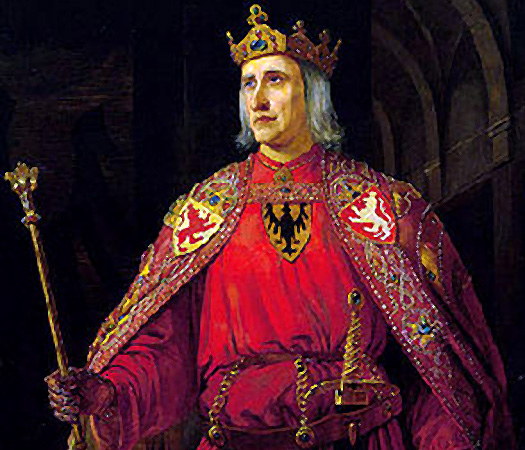 Rudolf, the son of Count Albert IV of Habsburg, and Hedwig, daughter of Count Ulrich of Kyburg, had inherited the large Habsburg estates around Habsburg Castle (in modern Switzerland), as well as lands in Alsace, and from that power-base he grabbed further power wherever it was available, fighting his way to the top Rudolf, the son of Count Albert IV of Habsburg, and Hedwig, daughter of Count Ulrich of Kyburg, had inherited the large Habsburg estates around Habsburg Castle (in modern Switzerland), as well as lands in Alsace, and from that power-base he grabbed further power wherever it was available, fighting his way to the top |
|
| 1282 - 1308 |
Albert I 'One-Eye' |
Son. HRE (1298-1308). Assassinated. |
| 1282 - 1290 |
Rudolph II |
Joint rule. 'Duke of [Swabia](GermanySwabia.htm#Dukes of Swabia)' (1289-90). |
| 1306 - 1307 |
Rudolph III |
HRE (1306-1307). King of [Bohemia-Moravia](EasternBohemia.htm#Wenceslas II) (1306-1307). |
| 1306 - 1307 |
Henry, youngest brother of Otto and Albert, counts ofTyrol, briefly becomes king of Bohemia as Jindrich (or Heinrich in its German form), but is quickly forced to step down by the powerful and ambitious Rudolph III. Rudolph is not at all welcome as far as the Bohemian nobles are concerned, and his early death in 1307 allows them to re-select Henry for the title. |
|
| 1308 |
Thanks to Albert's failure to address the problem of adequate compensation for the loss of [Styria](EasternStyria.htm#Slav Kingdom in Carinthia) in 1283 by Rudolph II, the king is assassinated by Rudolph's son, John. John is named 'Parricide', and continues to hold his inherited claim on [Swabia](GermanySwabia.htm#Dukes of Swabia). The death of Albert also loses for the Habsburgs the imperial crown until 1404, but the loss seems to energise them to expand and strengthen their personal possessions, especially under Rudolph IV, making them one of the most powerful noble houses in Europe. They also pursue John and his immediate family, slaughtering many of them.  As an Austrian duke of the Habsburg dynasty, Frederick IV 'the Fair' ruled over Further Austria (the largely-Swabian territories), and gained the county of Tyrol in 1406, while from 1424 he served as regent of Inner Austria for his nephews As an Austrian duke of the Habsburg dynasty, Frederick IV 'the Fair' ruled over Further Austria (the largely-Swabian territories), and gained the county of Tyrol in 1406, while from 1424 he served as regent of Inner Austria for his nephews |
|
| 1308 - 1330 |
Frederick IV the Fair |
Rival HRE and regent (1325-1330). |
| 1308 - 1326 |
Leopold VII |
Joint rule. |
| 1313 |
With the death of John Parricide, any claim to the former[Swabian](GermanySwabia.htm#Dukes of Swabia) duchy dies with him. Large areas of its territory have already gone to the established county of[Württemberg](GermanyWurttemberg.htm#County of Wurttemberg) and the margraviate of Baden. Territory formerly belonging to the Alemanni people also later forms parts of Austria (Vorarlberg),France (Alsace) and Switzerland, as well as the Bavarian Swabia region of[ Bavaria](GermanyBavarians.htm#Duchy of Bavaria %28Wittelsbachs%29). |
|
| 1314 - 1322 |
When Louis IV (Louis the [Bavarian](GermanyBavarians.htm#Duchy of Bavaria %28Wittelsbachs%29)) is elected Holy Roman Emperor in 1314, a minority faction elects Frederick the Fair of Hapsburg as emperor. Louis defeats Frederick in 1322, but the[Pope](ItalyPopes.htm#Great Schism) refuses to recognise or crown him, so Louis has himself crowned emperor by representatives of the Roman people. This coronation is part of an agreement that has been reached with Frederick whereby the latter is crowned king of the Romans to administer Germany as regent while Louis will fulfil his role from [Italy](ItalyKingdom.htm#Lords of Milan). |
|
| 1330 |
Frederick IV's death means that he is succeeded by the sons of the late Duke Albert I. The elder of the two sons also adds the county of Pfirt and several cities to his domains through his marriage in 1324 to Johanna of Pfirt, daughter of Count Ulrich III. |
|
| 1330 - 1358 |
Albert II the Wise |
Son of Albert I. Duke Albert II of[Carinthia](EasternCarinthia.htm#Duchy Habsburgs II) (1335-1358). |
| 1330 - 1339 |
Otto the Cheerful |
Brother. Joint rule. Duke Otto IV of[Carinthia](EasternCarinthia.htm#Duchy Habsburgs II) (1335-1339). |
| 1335 |
With the death of Duke Henry V of[Carinthia](EasternCarinthia.htm#Duchy Tirols), the now-vacant duchy is passed by Holy Roman Emperor Louis IV the Bavarian to Otto and Albert, the sons of Duke Albert I. The southern section of the Tyrol is added to Carinthia's holdings, all of this taking place on 2 May 1335. |
|
| 1344 |
Otto's son, Leopold II, is due to succeed him as duke of [Carinthia](EasternCarinthia.htm#Duchy Habsburgs II) once he comes of age, but his early death prevents that. With Otto's own individual line of Habsburgs extinct, the duchy passes to Frederick, the second son of Albert II. |
|
|
|
|
| Archdukes of Austria (Habsburg) AD 1358 - 1780 The title of archduke (erzherzog in German) was 'granted' to Austria in 1359, even though it had to be invented and proclaimed by the first archduke, Rudolph IV. The bluff was propagated to make up for the loss to the Habsburgs of the imperial title and their failure to receive an electoral vote in the Golden Bull of 1356 which was proclaimed by Emperor Charles IV. Instead, Rudolph created the Privilegium Maius, a document that had no authority behind it but which raised the dukes of Austria to archdukes, a new title, and one which granted them the same level of status as the seven prince-electors of theHoly Roman empire. The title would be claimed and used by each of Rudolph's successors and would become an honorific for all Habsburg males from the sixteenth century onwards. It would be eight years over a full century before a Habsburg again gained the imperial throne after Rudolph IV withdrew from his regency post in 1330, but once they did they held onto it for good. The descendants of the second archduke, Albert III, died out in 1457, and the divided Habsburg lands were reunited under Frederick V. The dukes of Austria were frequently also joint dukes of[Carinthia](EasternCarinthia.htm#Duchy Habsburgs II) and dukes of Styria, the latter of which had been a firm Austrian possession since 1192. (Additional information from External Link: The Kingdom of Galicia and Lodomeria, 1772, V J Kaye (Canadian Slavonic Papers, Vol 14, No 3 (Autumn, 1972), pp 454-464, Taylor & Francis Ltd, and available viaJSTOR).) |
|
|
| 1358 - 1365 |
Rudolph IV the Founder |
Son of Albert II. Ruled [Carinthia](EasternCarinthia.htm#Duchy Habsburgs II), Carniola, Tyrol &Styria. |
| 1363 |
Rudolph agrees with the widowed Margaret Maultash, countess of Gorizia-Tyrol, that upon the death of her only son, Meinhard III, he will inherit the county of Tyrol. In the end, Meinhard predeceases his mother and she remains in full command of the county until her own death in 1369, not least because her brother-in-law, Duke Stephen II of [Bavaria](GermanyBavarians.htm#Duchy of Bavaria %28Wittelsbachs%29), invades and holds the county. Once Rudolph's successor has the Tyrol safely under his control, the title of count would frequently be passed to junior members of the Habsburgs. |
|
| 1364 - 1365 |
The Carinthian march of Carniola is declared by Rudolph to be a duchy. In the following year he establishes the town of Novo Mesto in Lower Carniola (modern Slovenia). In German the town is known as Rudolfswert in his honour. Around the same time, he also agrees another contract of inheritance, this time with his father-in-law, Holy Roman Emperor Charles IV, which sets up the principle of mutual inheritance between the Habsburgs and the Luxemburg counts. One of Rudolph's last acts in 1365 is to found the University of Vienna as a rival to the University of Prague which had been founded by Charles IV in 1348. Rudolph has dedicated much of his efforts as archduke to increasing the prestige of Vienna, making it a major European capital. |
|
| 1365 - 1395 |
Albert III |
Brother. Duke of[Carinthia](EasternCarinthia.htm#Duchy Habsburgs II). Count of Tyrol (1386-1395). |
| 1365 - 1379 |
Leopold III the Just |
Brother. Joint rule. Duke[Carinthia](EasternCarinthia.htm#Duchy Habsburgs II). Count of Tyrol (1365-1386). |
| 1379 |
Albert and Leopold share the rule of Austria under the principles of Rudolph's 'Rudolfinian House Rules', but in reality all they do is quarrel. Their disputes threaten Austria's unity, so they agree to divide their holdings under the terms of the Treaty of Neuberg. Albert becomes sole archduke of Austria, while Leopold takes precedence in[Carinthia](EasternCarinthia.htm#Duchy Habsburgs II) (Inner Austria), Further Austria, Styria, and Tyrol. |
|
| 1395 |
Albert III dies at Schloss Laxenburg and his united realm is divided between three members of the family. His only son, Albert IV, succeeds him as archduke of Austria, William the Courteous retains[Carinthia](EasternCarinthia.htm#Duchy Habsburgs II) (Inner Austria) and Tyrol in place of his father, the late Leopold III, and Leopold IV retains Further Austria. |
|
| 1395 - 1404 |
Albert IV |
Son of Albert III. |
| 1404 - 1439 |
Albert V |
HRE Albert II. King of Bohemia (1437/8-1439), & Hungary. |
| 1406 |
The death of Duke William of[Carinthia](EasternCarinthia.htm#Duchy Habsburgs II), Carniola, Styria, now collectively referred to as Inner Austria, along with Tyrol at a relatively young age - he is about thirty six - sees his lands divided between his brothers. Frederick, who has already been sharing the rule of the Tyrol, gains that territory, while Ernest is granted Carinthia, Carniola, and Styria. Both brothers also act as guardians for the young Albert V. |
|
| 1407 - 1411 |
Duke Ernest of[Carinthia](EasternCarinthia.htm#Duchy Habsburgs II) (Inner Austria) has been in conflict with a brother, Leopold IV of Further Austria, and now their enmity erupts into civil war. It is resolved by 1409, and when Leopold dies in 1411 without having produced a male heir, Ernest becomes head of the house and sole ruler of both Inner Austria ([Carinthia](EasternCarinthia.htm#Duchy Habsburgs II), Styria, and Carniola) and Further Austria. |
|
| 1420 - 1421 |
Austria gains part of the partitioned province ofIstria. In the following year a pogrom is launched against Vienna's Jewish Diaspora community. |
|
| 1439 - 1440 |
A period of uncertainty is forced upon Austria andHungary by the death of Albert in battle at Langendorf against the Ottomans. His titles are claimed by Ladislas of[Bohemia](EasternBohemia.htm#House of Luxembourg), but Hungary is contested by Vladislav ofPoland. Elizabeth of Hungary is quickly imprisoned. Duke Frederick III of Inner Austria ([Carinthia](EasternCarinthia.htm#Duchy Habsburgs II), Styria, and Carniola) is elected king of theRomans in 1440. He begins to unite all of the divided Habsburg lands under one ruler, laying the foundations for the later greatness of the Habsburgs in Central Europe. |
|
| 1440 - 1457 |
Ladislas Posthumus |
King of Bohemia (1439-1457). |
| 1457 - 1458 |
The title is vacant for a year. With the accession of Frederick, son of Albert V, Holy Roman emperor and duke of [Carinthia](EasternCarinthia.htm#Duchy Habsburgs II), to the archduchy of Austria, the duchy of Carinthia is united fully to Austria. It remains an integral part of the Austrian succession until 1564. |
|
| 1458 - 1493 |
Frederick V 'the Fat' |
Son of Albert V.HRE Fdk III. Duke of [Carinthia](EasternCarinthia.htm#Duchy Habsburgs II) (1424). |
| 1477 |
The death of Charles the Bold of Burgundy ends Burgundian greatness. The lion's share of his domains are immediately annexed by Louis XI of France, while the sole heiress of Burgundy, Mary, marries Frederick V's son, Maximilian, the futureHoly Roman emperor. 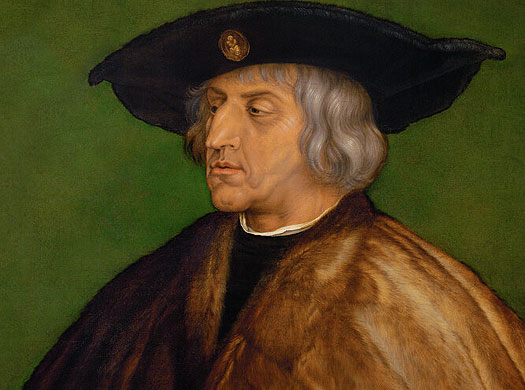 The sole heiress of Burgundy, Mary, married Maximilian of Austria, who became Holy Roman emperor in 1493 while also ruling the Habsburg Netherlands, Burgundy, and Austria The sole heiress of Burgundy, Mary, married Maximilian of Austria, who became Holy Roman emperor in 1493 while also ruling the Habsburg Netherlands, Burgundy, and Austria |
|
| 1493 - 1519 |
Maximilian I |
Son.HRE (1493-1519). Count of Tyrol (1490-1519). |
| 1493 |
The Peace of Senlis is signed between Maximilian and the French king, Charles VIII. This ends the latter's claim under Salic Law of ownership of the duchy of Burgundy following the deaths of Charles 'the Bold' of Burgundy in 1477 and his heiress daughter, Mary I of Valois in 1482 (Maximilian's wife). Maximilian has since altered his dynastic name from Valois-Burgundy to Habsburg. |
|
| 1508 - 1509 |
Maximilian officially gains the office ofHoly Roman emperor in 1508, even though he has effectively been holding the office since 1493 as 'King of the Romans'. In the following year the League of Cambrai is formed between France, Castile, Hungary, the Papal States, the Holy Roman empire, and Ferrara against Venice. Venice is defeated at Agnadello. |
|
| 1519 - 1520 |
Charles I |
HRE Charles V. Also in Spain &[Netherlands](FranceHolland.htm#House of Habsburg). Died 1558. |
| 1519 - 1534 |
Austria controls[ Württemberg](GermanyWurttemberg.htm#Duchy of Wurttemberg) directly. |
|
| 1520 - 1564 |
Ferdinand I |
HRE (1558-64). Count of Tyrol (1519). King of Bohemia & Croatia. |
| 1521 |
The French are again driven out of [Milan](ItalyKingdom.htm#Duchy of Milan), now by Habsburg Holy Roman Emperor Charles V who installs Duke Massimiliano's younger brother, Francesco II Sforza. His brief tenure is soon ended, however, again by a French occupation. |
|
| 1526 |
Following a devastating defeat at the Battle of Mohács and the death of Louis II ofHungary and Bohemia, Archduke Ferdinand inherits Hungary from the[ Lithuanian](EasternLithuania.htm#Grand Duchy of Lithuania) Jagiellos, but is opposed by the Zapolyas. |
|
| 1556 |
Upon the death of Charles I of Spain, the former HRE until 1520, his vast single dominion is divided between his son and his brother - although in practice this has been the case since Charles had invited Ferdinand to take over Austria in 1520. Charles' son, Philip, gains the throne of Spain, and the holdings in the [Netherlands](FranceHolland.htm#House of Habsburg), while his younger brother, Ferdinand, is confirmed in Austria, Bohemia, andHungary. Younger members of the royal house are also confirmed as dukes of [Carinthia](EasternCarinthia.htm#Duchy Habsburgs II) and counts of Tyrol, both following Ferdinand's death in 1564. 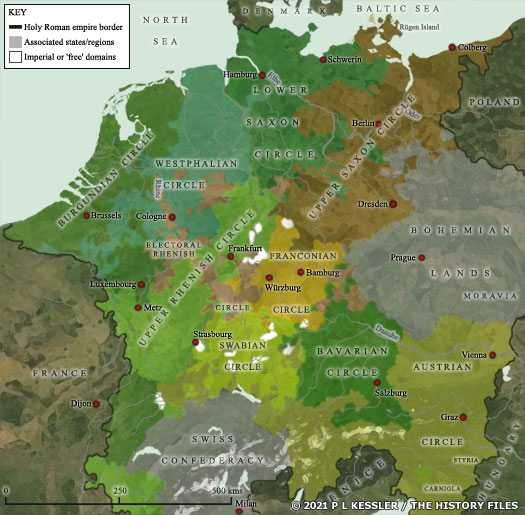 Introduced in 1560, the system of imperial states replaced the now-outdated feudal system, with an imperial circle ('reichskreis') being a regional grouping of the imperial states (click or tap on map to view full sized) Introduced in 1560, the system of imperial states replaced the now-outdated feudal system, with an imperial circle ('reichskreis') being a regional grouping of the imperial states (click or tap on map to view full sized) |
|
| 1564 - 1576 |
Maximilian II |
HRE (1564-1576). |
| 1576 - 1608 |
Rudolf V 'the Mad' |
HRE Rudolf II (1576-1612). |
| 1602 - 1605 |
Austria occupies Transylvania. |
|
| 1608 - 1619 |
Matthias |
Brother.HRE (1612-1619). King of Bohemia. |
| 1619 - 1637 |
Ferdinand II |
HRE. Duke of Inner Austria (Carinthia). RuledTyrol & Bohemia. |
| 1620 |
The Battle of White Mountain sees Ferdinand recapture rebellious Prague and Bohemia. This is the start of the Thirty Years' War. Bohemia is absorbed fully into the Holy Roman empire, where it remains until the empire's termination in its [Austrian](GermanyAustria.htm#Habsburg Emperors) form in 1918-1919. From the ruins of the empire, the republic ofCzechoslovakia is formed. |
|
| 1637 - 1657 |
Ferdinand III |
HRE. Duke of Inner Austria (Carinthia). |
| 1657 - 1705 |
Leopold VIII |
HRE Leopold I. |
| 1663 - 1664 |
The Fourth Austro-Turkish War ends in the Battle of Saint Gotthard on 1 August 1664 in which theOttomans are defeated by Austrian troops under Raimondo Montecuccoli (with a company of 140 men being led by Count Herman Adolph of Lippe-Detmold and also the exiled Duke Charles V of[Lorraine](FranceLorraine.htm#Duchy 2) in Imperial service). The Ottomans are forced to agree to the Peace of Vasvár with Austria. |
|
| 1665 |
Austria permanently absorbs the county of Tyrol. |
|
| 1683 |
John III of Poland and Charles V of [Lorraine](FranceLorraine.htm#Duchy 2) lift the siege of Vienna on 12 September, with support from Elector John George III of Saxony. The victory endsOttoman expansion in Europe by drawing a metaphorical line in the sand. 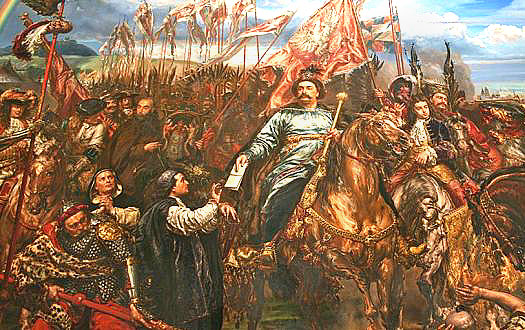 Jan Sobieski is pictured here, having played a vital part in lifting the Ottoman siege of Vienna in 1683 with perhaps the largest cavalry charge in history, consisting of 20,000 mounted men Jan Sobieski is pictured here, having played a vital part in lifting the Ottoman siege of Vienna in 1683 with perhaps the largest cavalry charge in history, consisting of 20,000 mounted men |
|
| 1699 |
The Treaty of Karlowitz is signed on 26 January 1699 at Sremski Karlovci (now inSerbia). This brings to a conclusion the Austro-Ottoman War of 1683-1697 which had witnessed the defeat of the Ottomans at the Battle of Zenta. The Ottoman advance in Europe is stopped in its tracks, and is even partially reversed for the first time. This allows Austria to rise as a dominant player in European politics. Khan Salim of the Tartars resigns his position following the treaty's signing while Austria takes permanent control of Transylvania. 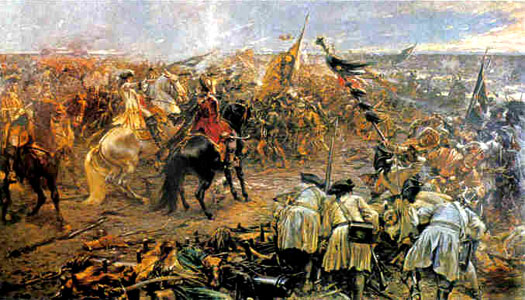 The Battle of Zenta in 1697 was a Habsburg and Holy League success against the Ottoman Turks in the Great Turkish War, with the Europeans being commanded by the brilliant Prince Eugene of Savoy The Battle of Zenta in 1697 was a Habsburg and Holy League success against the Ottoman Turks in the Great Turkish War, with the Europeans being commanded by the brilliant Prince Eugene of Savoy |
|
| 1702 - 1715 |
[Portugal](IberiaPortugal.htm#Kingdom of Braganza) initially supports France during the War of Spanish Succession but Britain alters the situation with the signing of the Methuen Treaty with Portugal on 16 May 1703. In December 1703 a military alliance between Austria, Britain, and Portugal sees them invade Spain. The allied forces capture Madrid in 1706, and [Lorraine](FranceLorraine.htm#Duchy 2) is occupied during the war, forcing the ducal court to flee. The campaign ends in a defeat at the Battle of Almansa. |
|
| 1705 - 1711 |
Joseph I |
HRE. |
| 1711 - 1740 |
Charles II |
HRE Charles VI. |
| 1713 |
The 'Pragmatic Sanction' is issued by Charles to ensure that the throne and Habsburg hereditary possessions can be inherited by a daughter, under agreement with all the leading nations. Until now these German lands have been governed under Salic Law which ensures only male succession, but Charles is the last male Habsburg in the direct line so a change is essential. |
|
| 1715 |
The conclusion of the War of the Spanish Succession sees Spain giving up Milan,Naples,Sardinia, and the Spanish Netherlands (modernBelgium) to Austria (to become known as the Austrian Netherlands), and [Sicily](ItalySicily.htm#Aragons United) to the duchy of Savoy. The Papal States are forced to hand over the territories of Parma and Piacenza to Austria, a definite blow to the papacy's prestige. Philip, duke of Anjou, is recognised as the Bourbon King Philip V of Spain, but only on the condition that the Bourbon crowns of Spain and France can never be united under a single ruler. |
|
| 1717 - 1720 |
King Philip V of Spain is unhappy with the arrangements set at the end of the War of Succession and occupies Sardinia and [Sicily](ItalySicily.htm#Aragons United), triggering the War of the Quadruple Alliance. The war begins with Philip's first actions of 1717, and is formally declared in 1718. Austria, Britain,France, and[Holland](FranceHolland.htm#House of Orange) unite to defeat Spain, and peace is again declared with the Treaty of The Hague which is signed in 1720. 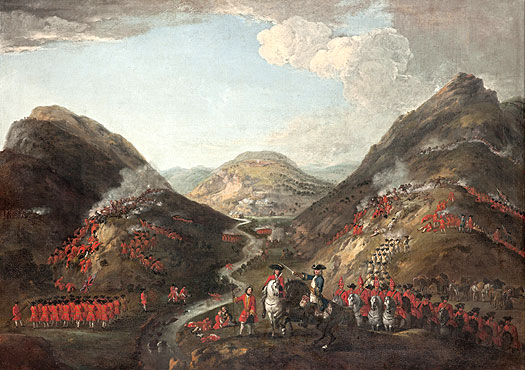 The Battle of Glenshiel in 1719 was the second and final defeat of a doomed small-scale Spanish-supported invasion of Scotland, part of the War of the Quadruple Alliance The Battle of Glenshiel in 1719 was the second and final defeat of a doomed small-scale Spanish-supported invasion of Scotland, part of the War of the Quadruple Alliance |
|
| 1735 - 1739 |
The recent Ottoman-Persian War and the subsequent peace treaty results now in the Austro-Russo-Turkish War (1735-1739). The main excuse for the war is continued raiding for slaves by the Crimean khanate on the Cossack Hetmanate of Ukraine, and a Crimean military excursion into the Caucasus. The Russians plunge deep into poorly-defended Crimean territory, burning as they go. Even the Ottoman fortress at Azov is captured, so that the caliph at Constantinople is forced to remove Crimean khans Qaplan Giray I (in 1736) and Fetih Giray II (in 1737) from their positions for their failures. Plague also sweeps through the combatants, sometimes reducing the fighting to little more than minor border skirmishes. Austria's own participation in the war against the Ottomans in 1737 ends in several Austrian defeats. |
|
| 1740 - 1780 |
Maria Theresa |
Dau. HRE. Heiress of Austria. m Francis III of[Lorraine](FranceLorraine.htm#Duchy 2). |
| 1740 - 1748 |
The War of the Austrian Succession is a wide-ranging conflict that encompasses the North American King George's War, two Silesian Wars, the War of Jenkins' Ear, and involves most of the crowned heads of Europe in deciding the question of whether Maria Theresa can succeed as archduke of Austria and, perhaps even more importantly, as Holy Roman Emperor. Austria is supported by Britain,Russia, Schaumburg-Lippe, the [Netherlands](FranceHolland.htm#House of Orange), the Savoyard kingdom ofSardinia, andSaxony (after an early switchover), but opposed by an opportunistic Prussia andFrance, who had raised the question in the first place to disrupt Habsburg control of Central Europe, backed up by[Bavaria](GermanyBavarians.htm#Duchy of Bavaria %28Wittelsbachs%29) and Sweden (briefly). Spain joins the war in an unsuccessful attempt to restore possessions lost to Austria in 1715 (such as Milan). 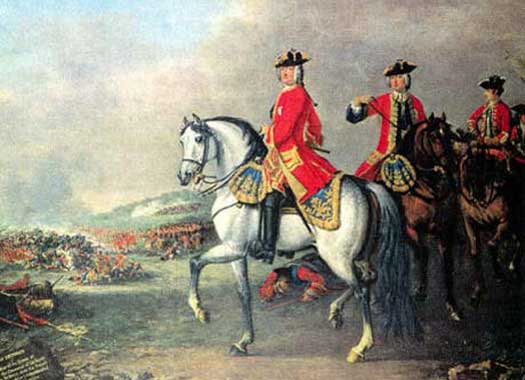 The War of the Austrian Succession saw Europe go to war to decide whether Maria Theresa would secure the throne left to her by her father, but several other issues were also decided as a wide range of wars were involved in the overall conflict The War of the Austrian Succession saw Europe go to war to decide whether Maria Theresa would secure the throne left to her by her father, but several other issues were also decided as a wide range of wars were involved in the overall conflict |
|
| The War of Jenkins' Ear pitches Britain against Spain between 1739-1748. The Russo-Swedish War, or Hats' Russian War, is the Swedish attempt to regain territory lost to Russia in 1741-1743. King George's War is fought between Britain and France in the [French Colonies](../KingListsAmericas/ColoniesFrench.htm#Governors General) in 1744-1748. The First Carnatic War of 1746-1748 involves the struggle for dominance in [India](../KingListsFarEast/IndiaStates.htm#Small States) by France and Britain. Henry Pelham, leader of the English government in Parliament, is successful in ending the war, achieving peace with France and trade with Spain through the Treaty of Aix-la-Chapelle. Austria is ultimately successful, losing only Silesia to Prussia. |
|
|
| 1756 - 1763 |
The Third Silesian War is sparked by Prussia pre-emptively invadingSaxony and temporarily occupying it as part of the Seven Years War. Saxon resources are channelled into Prussian hands while Frederick the Great pursues his war against Austria. When the Treaty of Hubertusburg is signed in 1763 to end the war, Saxony is forced to renounce its claim on Silesia. |
|
| 1773 |
As the recently-installed Austrian governor of the kingdom ofGalicia & Lodomeria, Count Pergen reports back to Maria Theresa on the state of this new sub-kingdom. 'The[ Ruthenians](EasternLithuania.htm#Grand Duchy of Lithuania) form two-thirds of the population and differ also in language from the Poles: all peasants from Red Rus', Beiz, and Podolia are Ruthenians, those of Cracow and Sandomierz are Poles.' |
|
|
|
|
| Archdukes of Austria (Lorraine-Habsburg / Baudemont) AD 1780 - 1806 |
|
|
| 1780 - 1790 |
Joseph II |
HRE. |
| 1787 - 1791 |
The Second Russo-Turkish War is part of the ongoing struggle for hegemony between the Russian and Ottoman empires around the Black Sea coast. Stung by the apparent permanent loss of the Crimea, the Ottoman empire launches a campaign to regain territory that had been lost to Russia in the previous Russo-Turkish War. The Ottomans have to fight on two fronts - the other being the Austro-Turkish War of 1787 - as Austria and Russia have agreed an alliance. Ottoman troops are hopelessly ill-prepared and badly led, and their defeats results in the sudden death of Sultan Abdul-Hamid I. Russia gains Yedisan (Odessa and Ochakov), while the Dniester becomes the new frontier. 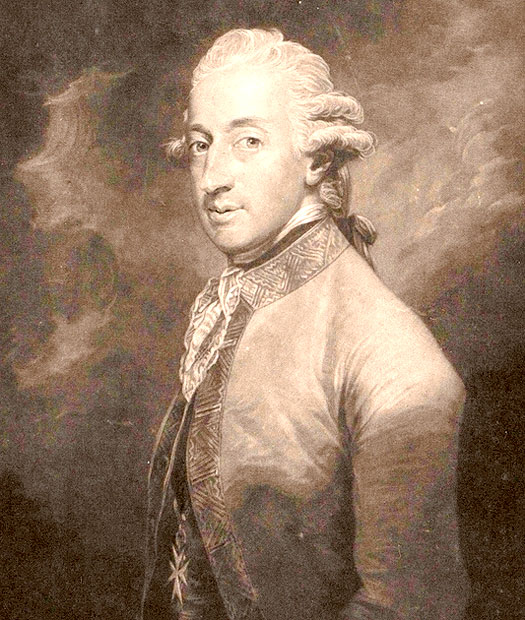 Count Ludovico di Barbiano di Belgiojoso, minister plenipotentiary in the southern Netherlands for Emperor Joseph II and a lieutenant field marshal of the Holy Roman empire Count Ludovico di Barbiano di Belgiojoso, minister plenipotentiary in the southern Netherlands for Emperor Joseph II and a lieutenant field marshal of the Holy Roman empire |
|
| 1790 - 1792 |
Leopold II |
HRE. Died suddenly. |
| 1792 - 1806 |
Francis II |
HRE. Last Holy Roman Emperor. |
| 1792 - 1797 |
Austria declares war on republican[France](FranceFranks.htm#First Republic), along with Prussia and the Savoyard kingdom ofSardinia, as part of the First Coalition. Prussia withdraws in 1795, along with Spain, and the coalition is ended in 1797, although Austria has already benefited in the partitions of Poland-Lithuania. The captured territories are formed into the kingdom of Galicia & Lodomeria. Austria also gains Dalmatia and the remainder of the province ofIstria, and all of the former republic of Venice in 1797. It loses portions of Italy to France and also theAustrian Netherlands. |
|
| 1799 - 1800 |
The Second Coalition is formed by Austria and Russia against republican [ France](FranceFranks.htm#First Republic). It ends in Austrian defeat at the Battle of Marengo, which eventually secures the French client republics in the[Netherlands](FranceHolland.htm#House of Orange-Nassau) and Italy. 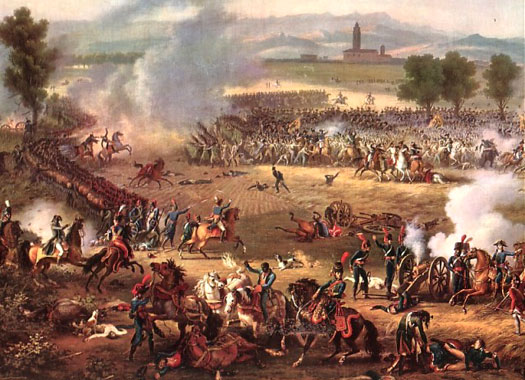 One of Napoleon's most brilliant achievements was his Italian campaign, which ended with the Battle of Marengo on 14 June 1800 - Austria was ejected from northern Italy and French power there was now unquestioned One of Napoleon's most brilliant achievements was his Italian campaign, which ended with the Battle of Marengo on 14 June 1800 - Austria was ejected from northern Italy and French power there was now unquestioned |
|
| 1805 |
The Third Coalition is formed against[France](FranceFranks.htm#First Empire), so in a swift campaign, Napoleon marches east and, in October, the outnumbered Austrian army of General Mack surrenders to him without battle at Ulm in [Bavaria](GermanyBavarians.htm#Kingdom of Bavaria). The French go on to occupy Vienna. On 2 December, Napoleon defeats large armies of Austrians and Russians at Austerlitz, and the coalition lays in ruins. Austria loses the county of Tyrol to [Bavaria](GermanyBavarians.htm#Kingdom of Bavaria). |
|
| 1806 |
The formal end of theHoly Roman empire is declared under the dictates of the[French](FranceFranks.htm#First Empire) Emperor Napoleon I. However, the Austrian empire retains most of its eastern possessions and is (to an extent) a continuation of the HRE in all but name. Archduke Francis II of Austria becomes Emperor Francis I of the [Austrian](#Habsburg Emperors) empire. |
|
|
|
|
 Emperors of Austria (Lorraine-Habsburg / Baudemont) AD 1806 - 1918 (Additional information from The First World War, John Keegan (Vintage Books, 2000).) Emperors of Austria (Lorraine-Habsburg / Baudemont) AD 1806 - 1918 (Additional information from The First World War, John Keegan (Vintage Books, 2000).) |
|
|
| 1806 - 1835 |
Francis / Franz I |
Formerly HRE Francis II. |
| 1806 |
[France](FranceFranks.htm#First Empire) creates the grand duchy of [Warsaw](EasternPoland.htm#Grand Duchy) out of Prussian Polish territories, so Austria appoints military governors to oversee its own Polish satellite kingdom of Galicia & Lodomeria. |
|
| 1807 |
Following the indecisive Battle of Eylau, Napoleon's [France](FranceFranks.htm#First Empire) utterly defeats the Austrians and Russians at the Battle of Friedland. The Russian army is forced to retreat in chaos from the battlefield, ending the Fourth Coalition and forcing Czar Alexander to negotiate for peace. |
|
| 1809 - 1810 |
A further disastrous Austrian defeat occurs in 1809, at the Battle of Wagram. In the same year, [Hessen-Darmstadt](GermanyHessenDarmstadt.htm#Grand Dukes) gains three Hessian domains of the German Order, the Fulda domain of Herbstein, and the estates of the Order of Malta in Hesse, no doubt due to this Austrian defeat. Further outcomes emerge in the following year, when [Bavaria](GermanyBavarians.htm#Kingdom of Bavaria) agrees to grant the Tyrol to Italy, while Istria, Dalmatia, and Ragusa are incorporated into the new [Illyrian Provinces](EasternCroatia.htm#Illyrian Provinces). In the same year, Napoleon Bonaparte makes what he thinks is an important dynastic link by marrying Archduchess Marie-Louise of Austria, although her father has no intention of voluntarily allowing any unity between the two countries. |
|
| 1814 |
With Napoleon's defeat and abdication, Austria regains the county of Tyrol from [Bavaria](GermanyBavarians.htm#Kingdom of Bavaria), as well as regaining control of its northern[Italian](ItalyKingdom.htm#Austria Restored) andPolish territories. Milan is occupied on 28 April 1814, and on 30 May the Treaty of Paris officially hands the remains of the kingdom ofItaly to Austria. |
|
| 1815 |
The Congress of Vienna reshapes Europe in a post-Napoleonic guise, albeit without particularly taking apart many of Napoleon's changes to the political structure in the German principalities. Austria itself cedes the Lublin region and surrounding areas - including much of WestGalicia - toCongress Poland. The Ternopil region - which includes southern Podolia - is returned to Austria by Russia. The city of Kraków and surroundings are removed from West Galicia to become a semi-autonomous free city under the supervision of Austria, Russia, andPrussia. |
|
| 1821 |
 Much of Europe's ruling elite breathes a sigh of relief when the news arrives that Napoleon Bonaparte has died in captivity of the island of St Helena in the south Atlantic. His son still lives, however, and as the new titular head of the House of Napoleon Bonaparte he is classed as a threat by the Austrians. Much of Europe's ruling elite breathes a sigh of relief when the news arrives that Napoleon Bonaparte has died in captivity of the island of St Helena in the south Atlantic. His son still lives, however, and as the new titular head of the House of Napoleon Bonaparte he is classed as a threat by the Austrians. |
|
| 1835 - 1848 |
Ferdinand (IV) |
Died 1875. |
| Archduke Franz Karl Joseph |
Brother. Renounced claim to throne in favour of his son. |
|
| 1846 |
Having been administered by a government senate since 1815, Ferdinand now terminates thePolish 'Kraków Republic', replacing it with a grand duchy with him holding the title. This arrangement remains in place until 1918. |
|
| 1848 - 1916 |
Francis Joseph / Franz Josef |
Son. Born 1830. |
| 1848 - 1849 |
In a year of European revolutions, a popular uprising known as the 'Five Days of Milan' drives the Austrians out of [Lombardy-Venetia](ItalyKingdom.htm#Austria Restored) on 22 March 1848 largely, it is said, due to the resentment built up by Viceroy Archduke Rainer's tax collections. Milan becomes the seat of the Provisional Government of Lombardy. On the following day, Venice experiences a similar uprising (and occupied Galicia has its own troubles), with the Provisional Government of Venice being formed. King Charles Albert of Savoy briefly goes to war against Austria in what is a short-lived encounter. He is defeated. In the following year he tries again and is similarly defeated in quick fashion, but the two attempts become known as the First War of (Italian) Independence. |
|
| Archduke Ferdinand Maximilian Joseph |
Brother. Viceroy of [Italy](ItalyKingdom.htm#Austria Restored) (1857-59). Emperor of Mexico (1864-67). |
|
| 1859 |
The Second Italian War of Independence sees [Lombardy](ItalyKingdom.htm#Austria Restored) taken from Austrian hands. The change in ownership is ratified in the same year by the Treaty of Zurich, creating the beginnings of a unified kingdom ofItaly. Venice is captured in 1866, formally terminating the Austrian kingdom of Lombardy-Venetia. Austria enters a period of internal reorganisation which includes the setting up of a legislative assembly forGalicia (a diet). At first it is dominated by pro-HabsburgPolish and Galician peasantry. The breaking out of disturbances in Russian-controlled Poland which spill over into Galicia means the diet soon ceases to sit. |
|
| 1866 |
Prussia fights the Austro-Prussian War against Austria, essentially as a decider to see which of the two powers will be dominant in Central Europe. Prussia gains the newly-created kingdom of Italy as an ally in the south and several minor German states in the north. Austria and its southern German allies are crushed in just seven weeks (giving the conflict its alternative title of the Seven Weeks' War), and Prussia is now unquestionably dominant. 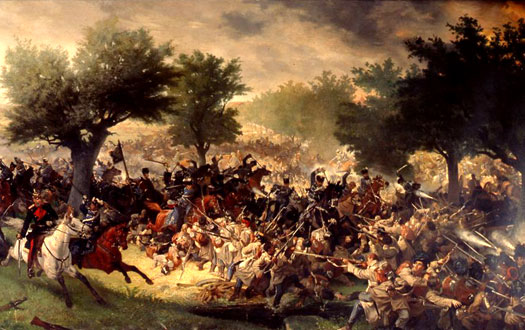 Austria's slow-moving forces were outpaced by Prussia's fully modern army during the Austro-Prussian War, which decided the power balance in Central Europe, as shown in this oil by Georg Bleibtreu Austria's slow-moving forces were outpaced by Prussia's fully modern army during the Austro-Prussian War, which decided the power balance in Central Europe, as shown in this oil by Georg Bleibtreu |
|
| Bismark oversees the seizure of four of Austria's northern German allies, the kingdom of Hanover, the electorate of Hessen-Kassel, and the duchy of [Nassau](FranceNassau.htm#Duchy Of Nassau), along with the free city of Frankfurt. Prussia also subsumes Schleswig and Holstein, although the former has technically been Prussian since 1864, and forces Saxe-Lauenberg into personal union (annexation in all but name, which turns into fact in 1876). Many of these gains ensure that Prussian territories in the east and west are now connected through the Rhineland and Westphalia. |
|
|
| 1867 |
The 'Austro-Hungarian Compromise' (Ausgleich in German and Kiegyezés in Hungarian) sets in place a dual structure for what henceforth will be the Austro-Hungarian empire. The compromise arrangement is a result of Austria's weakened position in Europe, especially inItaly and in German lands. The sovereignty of the kingdom of Hungary is restored following its loss in 1848. Emperor Francis Joseph is formally crowned king of Hungary on 8 June as the dual monarch of both nations. He will officially be known as the emperor and king. The sub-kingdom of Galicia & Lodomeria is now a crown land under the Austrian side of the power arrangement. |
|
| 1882 |
Italy and France disagree over their respective colonial expansionism so, seeing an opportunity to isolate France, Bismarck welcomes Italy into a Triple Alliance withPrussia and Austria. Italian relations with Berlin now enter their best period, although Vienna remains icily formal with its former subject. |
|
| Archduke Rudolph |
Son of Franz Josef. Committed suicide in 1889. |
|
| 1903 |
 Political manoeuvring denies the pro-French Cardinal Rampolla the office of pope to replace the late Leo XIII. Although Rampolla achieves the sufficient level of support during conclave, Cardinal Jan Puzyna de Kosielsko, archbishop of Krakow, delivers the veto on behalf of Franz Joseph. This is in revenge for the cardinal denying a church funeral for the emperor's son, Crown Prince Rudolph, when the latter had committed suicide. Political manoeuvring denies the pro-French Cardinal Rampolla the office of pope to replace the late Leo XIII. Although Rampolla achieves the sufficient level of support during conclave, Cardinal Jan Puzyna de Kosielsko, archbishop of Krakow, delivers the veto on behalf of Franz Joseph. This is in revenge for the cardinal denying a church funeral for the emperor's son, Crown Prince Rudolph, when the latter had committed suicide. |
|
| Archduke Franz Ferdinand |
Brother of Franz Josef and heir. Assassinated in Sarajevo in 1914. |
|
| 1912 - 1914 |
Albania, one of Europe's poorest states, became unexpectedly independent after the Albanian Uprising of 1912 and the First Balkan War (1912-1913). In November 1913, Albanian pro-Ottoman forces offer the Albanian throne to the Ottoman war minister, Izzet Pasha, but the provisional government executes his representative. In 1914, Austria-Hungary and Italy are able to select the German Prince Wied as the first prince of an independent Albania. |
|
| 1914 |
 The heir to the throne, Archduke Franz Ferdinand, is assassinated by Serb nationalists. The murder is used by Austria to declare war onSerbia, from which declaration the First World War results, with Germany becoming immediately involved as a close ally against Britain, France, andRussia. Austria's traditional enemy,Turkey, joins the German cause on 31 October. The heir to the throne, Archduke Franz Ferdinand, is assassinated by Serb nationalists. The murder is used by Austria to declare war onSerbia, from which declaration the First World War results, with Germany becoming immediately involved as a close ally against Britain, France, andRussia. Austria's traditional enemy,Turkey, joins the German cause on 31 October. |
|
| 1915 |
A combined Austro-Hungarian and German offensive in the east largely repulses theRussians fromGalicia. The Gorlice-Tarnów offensive starts out as a simple German attempt to relieve pressure on the Austro-Hungarian defences, but develops into the most major campaign of the year, with the Russian lines collapsing and Russian troops fleeing far into the Russian interior. Only bad weather in October ends the offensive. In the secret Treaty of London of 26 April,Italy agrees to abandon its allies, Germany and Austria-Hungary, declaring war on them instead in return for promises of almost all the Austrian territory it covets. However, on 6 September, Austria gainsBulgaria as an ally in its operations againstSerbia. |
|
| 1916 |
On 17 August,[Rumania](EasternRumania.htm#Kingdom of Rumania), long courted by the Allies, is finally persuaded by promises fromFrance andRussia that it will gain the principality of Transylvania fromHungary. Its war effort is quickly defeated when it attacks into Hungary instead of holding a front againstBulgaria, as agreed. |
|
| 1916 - 1918 |
Charles / Karl (III) |
Last Austrian emperor. Deposed (1918) and banished. |
| 1917 |
In April, Bolivia,Cuba, and the USA all side with the allies but Bolivia takes no active role in the war. In October,Brazil, Peru, and Uruguay also join the allied side, with Ecuador and Panama following suit in December. |
|
| 1918 - 1919 |
In April 1918, [Guatemala](../KingListsAmericas/CentralGuatemala.htm#Modern Guatemala) joins the allies, followed a month later by Costa Rica and Nicaragua. Honduras makes the same move in July. Austria-Hungary is fast failing, however. Its loyal subjects are tired of war and its many non-German and non-Hungarian peoples are becoming increasingly nationalist in thought and deed. Realising the inevitability of the break-up of the empire, on 16 October the emperor issues a manifesto to his people that, in effect, transfers the state into a federation of nationalities. He is too late. On 6 October, his Serb, Croat, andSlovene subjects form a provisional government of the 'SouthernSlavs', orYugoslavia. The day after, the Habsburg Poles unite with the former Russian and German-ruled Poles to declare a free and independent Poland, while on 28 October aCzecho-Slovak republic is declared in Prague, the capital of the former Bohemia and Moravia. On 30 October, the emperor's most loyal German subjects claim in a constituent assembly the right to govern themselves, effectively dismissing their former ruler from office. On 1 November, Austria's partner, Hungary, re-establishes itself as an independent kingdom (which, constitutionally, it already is). The other former imperial nationalities, Ruthenes and [Rumanians](EasternRumania.htm#Kingdom of Rumania), are already making provision for themselves, with the latter takingTransylvania. The troops of the empire begin to disarm themselves and head home, mostly to newly-created independent states. The new Austrian authority opens field negotiations with Italy (and theBritish and French forces which have been propping it up), and a ceasefire is agreed on 3 November 1918, although not fully recognised by the Italians until the following day. Italy gainsIstria for its efforts in the war. The Austrian empire has ceased to exist and Germany now stands alone. 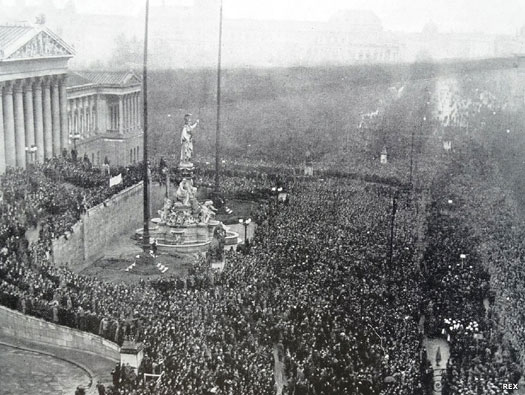 With the various peoples who made up its ethnically-diverse population pulling apart from it in 1918, Vienna was left with a rump state which greatly reduced its power and significance in post-Austro-Hungarian empire Europe With the various peoples who made up its ethnically-diverse population pulling apart from it in 1918, Vienna was left with a rump state which greatly reduced its power and significance in post-Austro-Hungarian empire Europe |
|
|
|
|
| Modern Austria AD 1918 - Present Day Located at the heart of Central Europe with Vienna as its capital, the modern republic of Austria has a population of nearly nine million (in 2018). It is entirely landlocked, being neighboured by Germany to the north-west, Czechia to the north, Slovakia to the north-east, Hungary to the east, Slovenia and Italy to the south, and Switzerland and Liechtenstein to the west. It was the Great War (or First World War) that brought the centuries-old[Habsburg](#Habsburg Emperors)-dominated Austrian state to an end. On 30 October 1918, the emperor's most loyal German subjects claimed the right to govern themselves, effectively dismissing their former ruler from office. On 1 November, Austria's major partner, Hungary, re-established itself as an independent state. Emperor Karl III was expelled from his Austrian domains and the empire was divided up into a series of democratic states which helped to shape modern Europe. The duchy of Bohemia was subsumed within Czechoslovakia and an aristocracy was abolished, ending the possibility of any titular claim being made there. The archduke and his family were forced out of Austria in 1919, and the Habsburg titles remain unrecognised there to this very day. Although the family has since been allowed to return they are not permitted to admit to any wish to reclaim their lost throne, having been forced to relinquish such claims in 1961. Even so, the legitimate successors to the imperial throne are given a shaded background in the list below even if they are not permitted to claim such a position. Several Habsburgs were also involved as rival Carlist claimants of the [Spanish](IberiaSpain.htm#Second Republic) throne during the early and mid-twentieth century. Modern Austria does not consider itself to be a legal successor to the former empire. However, its position at the geographical heart of Europe, and its neutral status during the Cold War between Nato and the Soviet bloc, maintained the much-reduced country's strategic significance. Following the 1956 Hungarian Revolution and the 1968 Prague Spring Invasion, Austria granted asylum to many refugees, reinforcing its position as a western bridgehead for Soviet Union evacuees. Austria is now a member of the European Union, but an enduring legacy of its decades of post-war neutrality can be seen in the large number of international organisations that call its capital their home. (Information by Peter Kessler, with additional information from A Concise History of Austria, Steven Beller (Cambridge University Press, 2006), from Austria In the Twentieth Century, Rolf Steininger, Günter Bischof, Michael Gehler (Eds, Transaction Publishers, 2008), from The First World War, John Keegan (Vintage Books, 2000), and from External Links: Otto von Habsburg (official site), and Otto von Habsburg (unofficial site, in German), and BBC Country Profiles, and Austria, the Official Travel Guide.) |
|
|
| 1918 - 1922 |
Charles / Karl (III) von Habsburg |
Last [Austrian](#Habsburg Emperors) emperor. Remained archduke. Died 1922. |
| 1919 - 1920 |
The 'Austrian First Republic' is created out of the ashes of the empire in 1919. Otto, Charles' son, is forced to flee the country on 24 March 1919. He goes into exile in Switzerland. The Canal Valley region of [ Carinthia](EasternCarinthia.htm#Duchy Habsburgs II) is ceded to the kingdom of Italy under the terms of the 1919 Treaty of St Germain which also defines Austria's modern borders. Liechtenstein establishes a legation in Austria, following the dissolution of its own historic close ties with the former[Austro-Hungarian](#Habsburg Emperors) monarchy (the legation closes in 1923). The Carinthian Plebiscite of 1920 sees the majority of Carinthia become a constituent state of Austria, which itself gains its constitution in the same year, while a small slice is adjoined to the kingdom of Serbs, Croats andSlovenes (the modern region of Slovenian Carinthia). 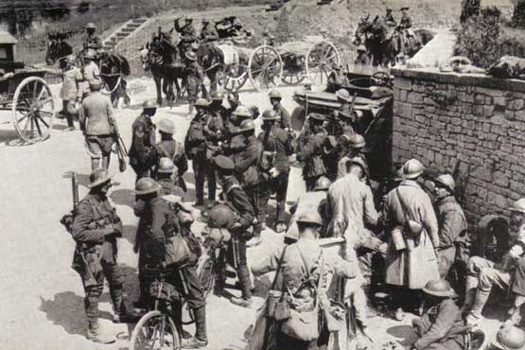 Austria in the period immediately following the declaration of the 1918 armistice struggled to find a new identity amid the collapse of the empire and its reformation into several independent sovereign states Austria in the period immediately following the declaration of the 1918 armistice struggled to find a new identity amid the collapse of the empire and its reformation into several independent sovereign states |
|
| 1922 - 1954 |
When Charles dies, Archduke Otto becomes head of the House of Habsburg with his mother, French-born Empress Zita, as guardian. Following a failed attempt to re-establish the empire in the same year, Otto is exiled to [Spain](IberiaSpain.htm#Bourbons Restored) until 1929, Belgium (1929-1940 - where he studies at university and gains a doctorate), France (1940), the USA (1940-1944), and then France and Spain again (1944-1954). |
|
| 1922 - 2007 |
Otto von Habsburg |
Son. Born 20 November 1912. Died 4 July 2011. |
| 1922 - 1930 |
Zita von Bourbon-Parma |
Mother and guardian. |
| 1934 |
With the Third Reich having only just been pronounced in neighbouring Germany, the Austrian government crushes a socialist uprising within its own borders, with backing against the socialists being provided by the army and the Heimwehr (Home Defence Force). All political parties are abolished except the Fatherland Front and Chancellor Engelbert Dollfuss dismisses parliament in April. Just three months later he is assassinated and replaced by Kurt von Schuschnigg. |
|
| 1936 |
The republican Popular Front government in [Spain](IberiaSpain.htm#Second Republic) defeats the right wing National Front in elections, forming the new government. In July, General Francisco Franco and a combination of monarchists and conservatives initiates a coup d'etat which triggers the Spanish Civil War. Franco makes it clear that he will never accept the Carlist claimant, Alfonso Carlos, as king, instead preferring to play diplomatic games with all three claimants, the last of these being Archduke Charles of Habsburg and Bourbon, a grandson of Charles (VII) of Bourbon Spain through the female line. |
|
| 1938 - 1945 |
Austria is forcibly annexed to Nazi Germany by Adolf Hitler in 1938, with the act being termed the 'Anschluss' (union). Austria now finds itself being renamed as the Ostmark (the 'eastern march'). The name effective returns Austria to its roots as the eastern border territory ('march' meaning a border area - see also Mercia in early England), immediately prior to the first [ Austrian Margraviate](#Regensburg Margraves) being confirmed around AD 960. The prince of Liechtenstein, Francis Joseph, leaves his ancestral holdings in Austria at Liechtenstein Castle near Vienna, and moves permanently to his principality on the eastern edge of Switzerland. Hitler launches Operation Barbarossa on 22 June 1941, this being the code name for the Axis invasion of theSoviet Union. The act opens what becomes known as the Eastern Front into which millions of Axis troops are sucked, including large numbers of the Austrian military forces. |
|
| 1945 - 1950 |
Soviet troops liberate Vienna during the German collapse of 1945. Renamed Austria, the country is occupied by Soviet, British, United States, and French forces. The German defeat triggers mass reprisals against anything and anyone with German links, especially in the east. Much of the German-speaking population is expelled into Germany by Eastern European states, creating one of the biggest population movements of the modern age. With Austrians also having lived for centuries in various territories within the former [Austrian](#Habsburg Emperors) empire, its citizens also suffer, but perhaps not to the extent of those of Germany. All of this takes place alongside millions of other displaced persons trying to get back to their home countries through the chaos of the immediate post-war period. 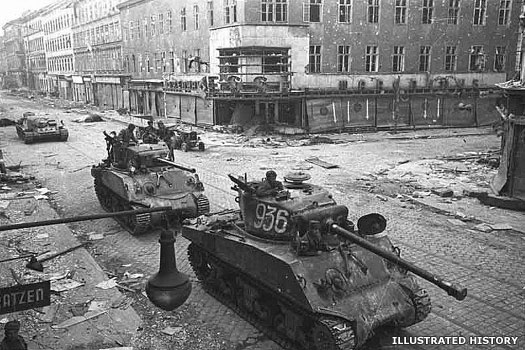 Allied tanks and other military vehicles are shown here in Vienna, which bears the scars of the intense fighting that was seen here in the Second World War's last year Allied tanks and other military vehicles are shown here in Vienna, which bears the scars of the intense fighting that was seen here in the Second World War's last year |
|
| 1955 |
The State Treaty is signed by Britain, France, the USA, and the Soviet Union, establishing an independent but neutral Austrian Second Republic. The state becomes a front line player in the Cold War, providing as it does one of the best conduits into the Soviet bloc. At the same time Austria joins the United Nations, the post-war replacement for the League of Nations. |
|
| 1951 - 1999 |
In 1951 Otto marries Princess Regina von Saxonia Sachsen-Meiningen (born 1925). From 1966, after relinquishing his claim to inherit the empire (in 1961), he is allowed access into Austria, and becomes a member of the European Parliament for the CSU on 10 June 1979. In 1999 he stands down for health reasons, by which time Austria is a member of the European Union (in 1995). |
|
| 2007 |
Otto relinquishes his status as head of the House of Habsburg in favour of his son and heir, Karl. This act, on 1 January 2007, is due to Otto's failing health and increasing age - he is ninety-four. Karl is the fifth of Otto's seven children, the first four all being girls. With him being the legitimate heir to the Habsburg titles, his younger brother, George, is the 'spare'. |
|
| 2007 - Present |
Karl von Habsburg-Lothringen |
Son of Otto. Born 11 January 1961. |
| Ferdinand von Habsburg-Lothringen |
Son and heir. Born 21 June 1997. |
|
 |
|
|
 Germany in AD 962 may have had its new emperor to govern those territories which are shown within the dark black line, but it was still a patchwork of competing interests and power bases (click or tap on map to view full sized)
Germany in AD 962 may have had its new emperor to govern those territories which are shown within the dark black line, but it was still a patchwork of competing interests and power bases (click or tap on map to view full sized) King Przemysl II Ottokar the Great, the 'Golden and Iron', was an inspirational empire-builder for his Czech kingdom of Bohemia-Moravia - he was also a capable politician, who managed to bring the state out of crisis and greatly strengthen it
King Przemysl II Ottokar the Great, the 'Golden and Iron', was an inspirational empire-builder for his Czech kingdom of Bohemia-Moravia - he was also a capable politician, who managed to bring the state out of crisis and greatly strengthen it Rudolf, the son of Count Albert IV of Habsburg, and Hedwig, daughter of Count Ulrich of Kyburg, had inherited the large Habsburg estates around Habsburg Castle (in modern Switzerland), as well as lands in Alsace, and from that power-base he grabbed further power wherever it was available, fighting his way to the top
Rudolf, the son of Count Albert IV of Habsburg, and Hedwig, daughter of Count Ulrich of Kyburg, had inherited the large Habsburg estates around Habsburg Castle (in modern Switzerland), as well as lands in Alsace, and from that power-base he grabbed further power wherever it was available, fighting his way to the top As an Austrian duke of the Habsburg dynasty, Frederick IV 'the Fair' ruled over Further Austria (the largely-Swabian territories), and gained the county of Tyrol in 1406, while from 1424 he served as regent of Inner Austria for his nephews
As an Austrian duke of the Habsburg dynasty, Frederick IV 'the Fair' ruled over Further Austria (the largely-Swabian territories), and gained the county of Tyrol in 1406, while from 1424 he served as regent of Inner Austria for his nephews The sole heiress of Burgundy, Mary, married Maximilian of Austria, who became Holy Roman emperor in 1493 while also ruling the Habsburg Netherlands, Burgundy, and Austria
The sole heiress of Burgundy, Mary, married Maximilian of Austria, who became Holy Roman emperor in 1493 while also ruling the Habsburg Netherlands, Burgundy, and Austria Introduced in 1560, the system of imperial states replaced the now-outdated feudal system, with an imperial circle ('reichskreis') being a regional grouping of the imperial states (click or tap on map to view full sized)
Introduced in 1560, the system of imperial states replaced the now-outdated feudal system, with an imperial circle ('reichskreis') being a regional grouping of the imperial states (click or tap on map to view full sized) Jan Sobieski is pictured here, having played a vital part in lifting the Ottoman siege of Vienna in 1683 with perhaps the largest cavalry charge in history, consisting of 20,000 mounted men
Jan Sobieski is pictured here, having played a vital part in lifting the Ottoman siege of Vienna in 1683 with perhaps the largest cavalry charge in history, consisting of 20,000 mounted men The Battle of Zenta in 1697 was a Habsburg and Holy League success against the Ottoman Turks in the Great Turkish War, with the Europeans being commanded by the brilliant Prince Eugene of Savoy
The Battle of Zenta in 1697 was a Habsburg and Holy League success against the Ottoman Turks in the Great Turkish War, with the Europeans being commanded by the brilliant Prince Eugene of Savoy The Battle of Glenshiel in 1719 was the second and final defeat of a doomed small-scale Spanish-supported invasion of Scotland, part of the War of the Quadruple Alliance
The Battle of Glenshiel in 1719 was the second and final defeat of a doomed small-scale Spanish-supported invasion of Scotland, part of the War of the Quadruple Alliance The War of the Austrian Succession saw Europe go to war to decide whether Maria Theresa would secure the throne left to her by her father, but several other issues were also decided as a wide range of wars were involved in the overall conflict
The War of the Austrian Succession saw Europe go to war to decide whether Maria Theresa would secure the throne left to her by her father, but several other issues were also decided as a wide range of wars were involved in the overall conflict Count Ludovico di Barbiano di Belgiojoso, minister plenipotentiary in the southern Netherlands for Emperor Joseph II and a lieutenant field marshal of the Holy Roman empire
Count Ludovico di Barbiano di Belgiojoso, minister plenipotentiary in the southern Netherlands for Emperor Joseph II and a lieutenant field marshal of the Holy Roman empire One of Napoleon's most brilliant achievements was his Italian campaign, which ended with the Battle of Marengo on 14 June 1800 - Austria was ejected from northern Italy and French power there was now unquestioned
One of Napoleon's most brilliant achievements was his Italian campaign, which ended with the Battle of Marengo on 14 June 1800 - Austria was ejected from northern Italy and French power there was now unquestioned Emperors of Austria (Lorraine-Habsburg / Baudemont) AD 1806 - 1918 (Additional information from The First World War, John Keegan (Vintage Books, 2000).)
Emperors of Austria (Lorraine-Habsburg / Baudemont) AD 1806 - 1918 (Additional information from The First World War, John Keegan (Vintage Books, 2000).) Much of Europe's ruling elite breathes a sigh of relief when the news arrives that Napoleon Bonaparte has died in captivity of the island of St Helena in the south Atlantic. His son still lives, however, and as the new titular head of the House of Napoleon Bonaparte he is classed as a threat by the Austrians.
Much of Europe's ruling elite breathes a sigh of relief when the news arrives that Napoleon Bonaparte has died in captivity of the island of St Helena in the south Atlantic. His son still lives, however, and as the new titular head of the House of Napoleon Bonaparte he is classed as a threat by the Austrians. Austria's slow-moving forces were outpaced by Prussia's fully modern army during the Austro-Prussian War, which decided the power balance in Central Europe, as shown in this oil by Georg Bleibtreu
Austria's slow-moving forces were outpaced by Prussia's fully modern army during the Austro-Prussian War, which decided the power balance in Central Europe, as shown in this oil by Georg Bleibtreu Political manoeuvring denies the pro-French Cardinal Rampolla the office of pope to replace the late Leo XIII. Although Rampolla achieves the sufficient level of support during conclave, Cardinal Jan Puzyna de Kosielsko, archbishop of Krakow, delivers the veto on behalf of Franz Joseph. This is in revenge for the cardinal denying a church funeral for the emperor's son, Crown Prince Rudolph, when the latter had committed suicide.
Political manoeuvring denies the pro-French Cardinal Rampolla the office of pope to replace the late Leo XIII. Although Rampolla achieves the sufficient level of support during conclave, Cardinal Jan Puzyna de Kosielsko, archbishop of Krakow, delivers the veto on behalf of Franz Joseph. This is in revenge for the cardinal denying a church funeral for the emperor's son, Crown Prince Rudolph, when the latter had committed suicide. The heir to the throne, Archduke Franz Ferdinand, is assassinated by Serb nationalists. The murder is used by Austria to declare war onSerbia, from which declaration the First World War results, with Germany becoming immediately involved as a close ally against Britain, France, andRussia. Austria's traditional enemy,Turkey, joins the German cause on 31 October.
The heir to the throne, Archduke Franz Ferdinand, is assassinated by Serb nationalists. The murder is used by Austria to declare war onSerbia, from which declaration the First World War results, with Germany becoming immediately involved as a close ally against Britain, France, andRussia. Austria's traditional enemy,Turkey, joins the German cause on 31 October. With the various peoples who made up its ethnically-diverse population pulling apart from it in 1918, Vienna was left with a rump state which greatly reduced its power and significance in post-Austro-Hungarian empire Europe
With the various peoples who made up its ethnically-diverse population pulling apart from it in 1918, Vienna was left with a rump state which greatly reduced its power and significance in post-Austro-Hungarian empire Europe Austria in the period immediately following the declaration of the 1918 armistice struggled to find a new identity amid the collapse of the empire and its reformation into several independent sovereign states
Austria in the period immediately following the declaration of the 1918 armistice struggled to find a new identity amid the collapse of the empire and its reformation into several independent sovereign states Allied tanks and other military vehicles are shown here in Vienna, which bears the scars of the intense fighting that was seen here in the Second World War's last year
Allied tanks and other military vehicles are shown here in Vienna, which bears the scars of the intense fighting that was seen here in the Second World War's last year